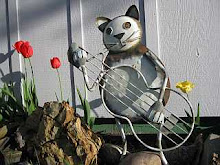CHS sent my hay sample to a lab to be tested. They lent me the following device to grind up and gather hay samples.
 |
| How one gets a hay sample from a bale. |
To get a representative sample from across the whole field, I gathered hay from a half dozen or more hay bales. I filled a plastic baggie with the hay and this was sent to the lab for testing.
So I could have a nitrate level up to 700 and be safe. My sample came back at 91. I wasn't even close to 700. I was well below the maximum value to be safe.
Since I was having the hay tested I also had the basic test done for overall hay quality.
For me the key value was RFV. RFV means: Relative Feed Value. I was disappointed in my RFV. I had a value of 90.44. Definitely in the lowest class of quality.
The rest of the values I could not interpret as there were no charts indicating their appropriate levels. I spoke with Andy, the feed agronomist at CHS. For the items he was interested in, he thought the values were fine. As to the RFV, he asked if I waited too long to cut the crop whereby the nutrition had gone into the heads and seeds before I cut the crop. No, I don't think so. I could have cut the crop a few days earlier but I did cut the crop within seven days of when the crop first began to head out.
I explained the cut crop got soaked in the freak rainstorm and he felt that was what lowered my RFV.
Later after I cut the neighbor's field with grass that stands in the water for a while in the Spring when the river is high, I tested that hay. To my surprise its RFV was higher at 98. Still in the lowest class of hay quality, but slightly better than my crop.
I usually give my cattle a SmartLic supplement in their last trimester of pregnancy. This year I will buy a second SmartLic tub so the cattle can lick it much of the Winter as they eat the various hay.







No comments:
Post a Comment